Inline Euros 2014 – Day 7
The final day of euros is of course the day of the marathons. Ordinarily, this is only a half day’s worth of racing leaving skaters with a good few hours to get scrubbed up for the party in the evening. However today’s racing took up the entire day owing in large part to the inclusion of ‘masters’ divisions, as well as significant delays due to rain and helicopter.
The observant reader will have noticed that there are two divisions of junior skaters – ‘junior A’ and ‘junior B’. At my first international competition, junior anything didn’t exist and so I raced in what was known as the ‘open’ division which only had a minimum age requirement of 12. ‘Junior’ divisions have been around in various forms for a long time, but world championships didn’t have an official junior division until about 1998 (I may be wrong on this). Back then, junior was exactly what you would expect – 17 years and under, while senior was 18 and over. For a time, European championships also included a lower division called ‘cadet’ which I believe included 14 and 15 year olds.
I photographed the track portion of European Championships in 2009 for the Dutch team, and back then cadet, junior, and senior were all held as one competition. Now, there doesn’t seem to be an official cadet european championships, and instead the bulk of the competition I’ve just been covering has consisted of junior A, junior B, and senior. Junior B is for 16 and 17 year olds, while junior A is for 18 and 19 year olds. Why this new age division? I think the idea was to follow the age divisions for ice speed skating, where one is a junior so long as they are 19 years of age or below on the 1st of July of the year in which the season begins. Now, possibly in recognition of the significant role that the masters age group plays in the sport of inline speed skating, masters European championships and world championships are now ‘a thing’.
While I am technically able to race in the masters division, I won’t – mostly because the only races they have are marathons, and I’m really much more of a short-distance person. There are also quite a number of masters divisions – 30 and over, 40 and over, 50 and over, 60 and over, and 70 and over (I’m not making that up). This is part of the reason that I’m writing this report at 3:30am after returning to the hotel after the afterparty, rather than writing it just after lunch. Not only are there additional divisions to be contested, but (as you can probably imagine) it takes a 70-year-old much longer to complete the marathon distance than even the junior ladies.
The marathons themselves were a little uninspiring to be perfectly honest. Often, over the course of such a long race, there are multiple ‘attacks’ where one or more skaters will initiate an attempt at a breakaway. If, say three French skaters break away from the peloton, then the Italians, Germans, Dutch, or whoever would work together in the pack to chase down the smaller group because a large group of skaters sharing the leads is faster than a smaller group. However, if the breakaway group is mixed, say a Frenchie and a Dutchie, then the French skaters and Dutch skaters who are left behind in the pack will try to keep the pace slow either by going to the front and slowing it down, or by simply not taking any leads. This is because if they have a skater in the breakaway who is assured of getting a medal, then it’s best to leave it at that, rather than to chance it in a pack sprint, where generally the fastest sprinter who can last 42km will win.
There are numerous strategies a team can employ, including attacking and forcing other teams to chase while leaving one designated winner behind in the pack ‘protected’ and able to stay fresh for the final sprint. Group breakaways of course often do happen, and then it is up to the pack as to whether or not, and in what manner they chase. Sometimes it is optimal to allow the breakaway group to stay away for a long time and get tired, before swallowing them up in the pack again, and this also allows the worker bees in the pack to save a little energy. Also, since in the marathon teams are allowed to enter many more skaters than they can on the other competitions (track and road) they can also use skaters to ‘block’ good skaters from other teams.
However, in this round of marathons, in the junior A ladies, junior A men, and senior mens divisions (junior B’s aren’t allowed to do a marathon for some inexplicable reason) were all decided by a single decisive breakaway. Nobody got chased down, there were no multiple attacks, there just wasn’t very much of the ‘action’ that one is accustomed to seeing at a high-level marathon. Even in the senior ladies, where there were several attempts at attacking, none were very successful, and in the end it came down to a pack sprint won by the girl with probably the highest top-speed and the poorest luck of the tournament – Manon Kamminga of the Netherlands. The senior mens division was also marred by the very unusual move of stopping the race (at the time, announced as a ‘pause’) when it started to rain. Deciding, correctly, that to resume the race with only half the distance remaining after a 30 minute break was unfair, the officials decided to restart the race in its entirety.
Also worthy of note is that Claudia Pechstein, who has won 5 olympic gold medals over a career spanning 6 Olympic Games’ started in the under 50 division for Germany, and Cathrine Grage, who represented Denmark at the 2010 Vancouver games (and that set in motion a chain of events which ultimately led me to move to Denmark), started in the under 40 division for Denmark. They both easily won their categories.
Part of the reason for this may have been the course itself. It was quite technical consisting of a fairly steep uphill section and one very sharp corner which was just after a long, straight downhill section (affectionately named ‘death corner’). This made it a little bit difficult to break away since there was a speed bottleneck, and it also made it just a little bit more scary for those who had broken away to maintain the kind of high speed laps required to make a gap on the pack. Luckily there were very few falls, although there was one bad one which required a helicopter airlift and also delayed the program significantly.
Full results for all of the divisions of marathon skaters (and there are many) can be found here.
Don’t forget to check out the photo page. Also worth looking at is the photo page for 2009 euros, and having a look at who’s still around and who isn’t, and also how some young skaters have grown into senior skaters.

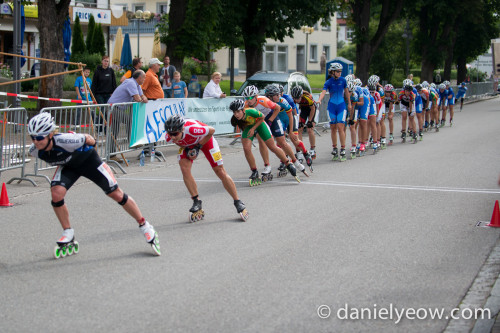
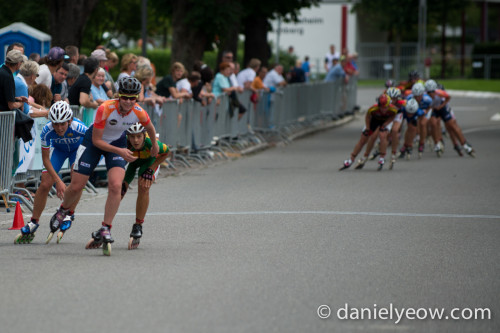
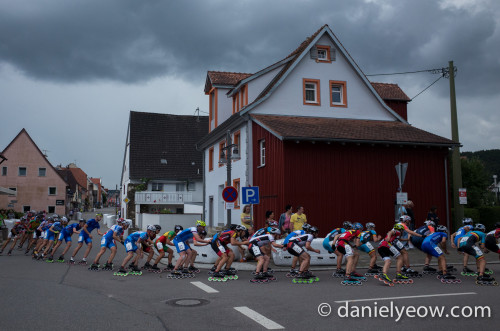
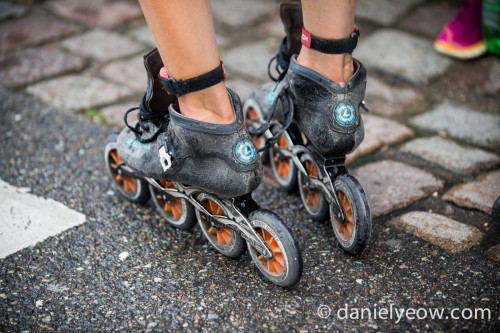
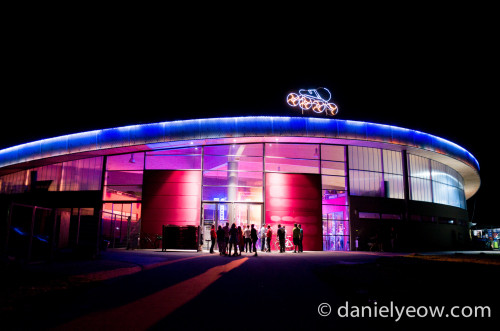
Leave a comment